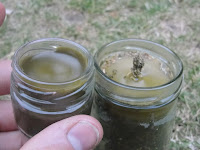I was pleased that in this build up he sent me a friend
request on Facebook and after a few posts I decided to ask him if he’d be happy
to do a spoof email for me to use at Cubs to get them to see that knots aren’t
boring, he was only too happy to help and along with one from Bushcraft &
Survival Skills editor Simon Ellar and they ultimately became part of an
article in Scouting magazine’s Cub supplement which in turn led to me doing
articles for future issues. Paul has also done (and is indeed still doing)
articles of his own for Scouting magazine and did not one but two articles for
the recent Scouting book The Outdoor Manual.
The reason for this prolonged passage is to explain why I
wanted to do a Frontier Bushcraft course; Paul’s former prominent position at
Woodlore was one factor, the other being to meet the guy who had agreed to help
The Scout Association with articles when a middle aged hobbyist bushcrafter
asked him across the internet (that strange thing of getting to know someone
without actually meeting them).
This happened on the Frontier 3-day taster course in late
May/ early June. I’m doing a limited blog about it because I’ve done a course
review article for Bushcraft and Survival Skills magazine due out at the end of
June and I’ve made it more personal, as opposed to a more factual article and
covered some bits that I didn’t include.
The course is in East Sussex and booking is easy and
directions good. The rainy half term weekdays gave way to a sunny cloudy end of
the week…it can rain on a course (of course!) and you just have to get on with it, but sunny/ cloudy is good.
I finally met with Paul on a grassy area outside a pub (the
easy to find meeting place) and Henry, who folk may recall did a fantastic blog
tutorial on a folding bucksaw (I told him that I hold it against him
because it’s *too good*). Also I attendance was assistant Stuart.
The cold spring did give us the bonus of a late, and frankly
stunning, display of bluebells in our corner of the 500 acre estate that we
were on; the only problem was trying not to inflict excessive damage on them!
Luckily there were well worn paths which helped, and when I had chosen my spot
to pitch my tarp (I was a bit choosy) I found a small pathway through them to
the main camp area which I stuck to.
One advantage was that there was
only one other individual who had a real interest in bushcraft which meant that
I could chat to the instructors without having to share too much, one
disadvantage was that there was only one other
individual who had a real interest in bushcraft which meant that there wasn’t
much bouncing of ideas around between attendees.
I'm sure I'm not the only one who finds a big fresh air appetite well fear not, you won't go hungry on the course. I go into more detail in the article but there's plenty for everyone and it's by and large prepped by the attendees. I'm absolutely no fan of mushrooms (except alcohol soaked chocolate covered Judas Ear!) but a vegetarian had some Porcini mushrooms in a stew and I tried one...It must be the fresh air as I rather liked it as it had soaked up some stock.
This course is really three days…three full days of tutoring so expect early starts and late ends to cram everything in. It is also worth noting that nearly all the stuff taught is linked up; fire started with one match fire lighting, lighting then cooking on fire, ferro rod usage, then flint and steel with a tinder bundle as a good example.
I felt that Paul and Henry dovetailed well when presenting a topic, ably assisted by Stuart and if I had to pick a favourite topic from each I think that Henry’s rabbit prep was great, and Paul’s sharpening demo was very useful to someone whose sharpening needed sharpening (*groan*)…It actually was mostly about sharpening, rather than just a knife porn session. It was a good session anyway on a subject that I needed to improve upon but Paul also looked at my custom made knife which I’d got into problems with and not only talked me through the problem and how to sort it, but also had an initial crack at it to help me on my way! I have a waterstone set at home but I've purchased an oil stone as I seemed to get on well with it…I’ll have a go at the waterstones too because it could be that I am a little more proficient in my action.
If your aim is to visit different bushcraft schools to
experience different locations, styles etc then make sure Frontier bushcraft
are on that list…they’ll be the ones to beat in the next Best in Bushcraft
awards. I put up a selection of pictures in a public gallery on Facebook if
anyone wishes to see them here.
Just one final point to make; Paul explained that he spends about half the year outside so if you ever message him be patient!





























































































